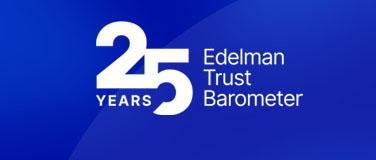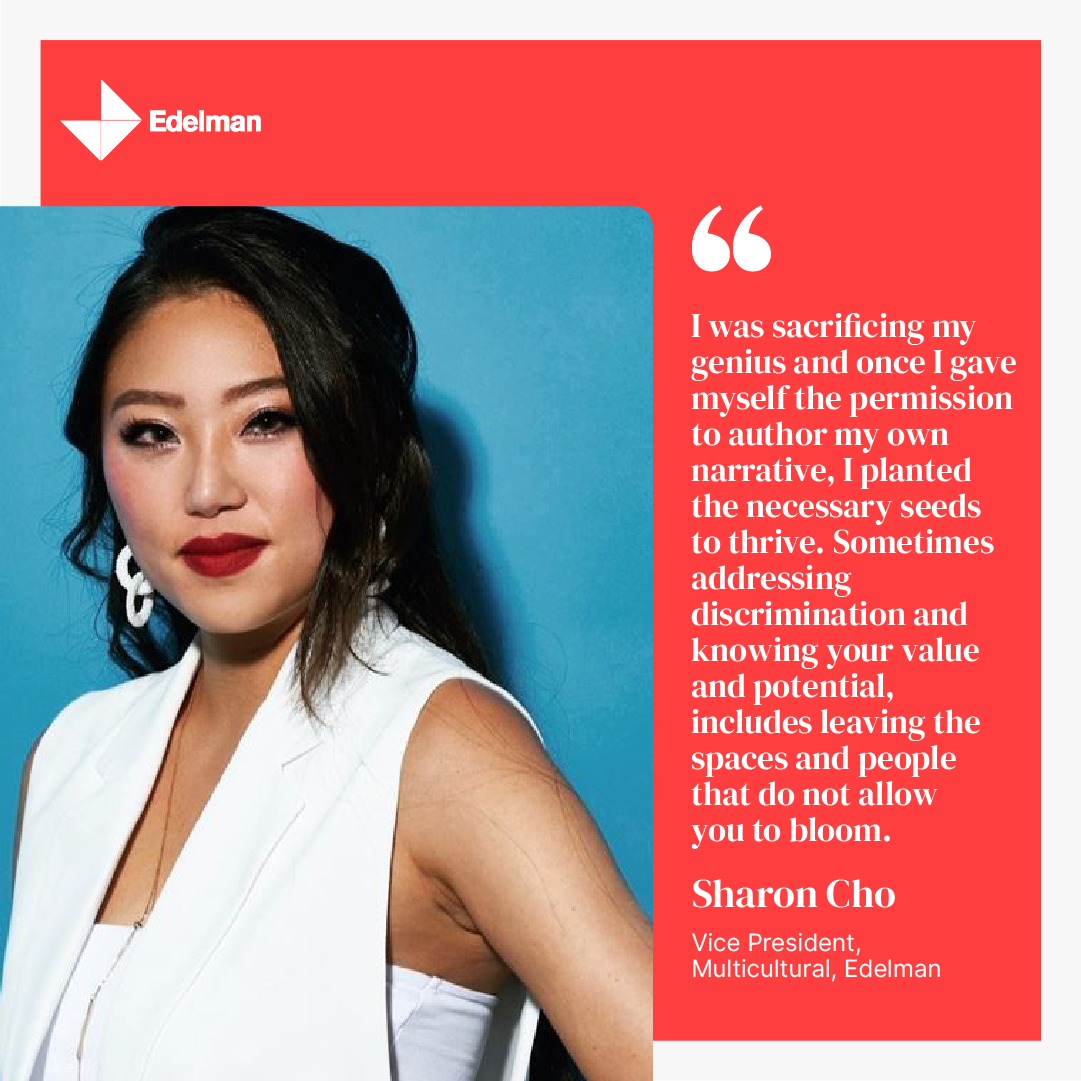In honor of International Women's Day, we are excited to present a special edition of our Inside Edelman series, dedicated to promoting gender equity and raising awareness of the challenges and threats that women still face today. By highlighting inspiring voices from across our network, we hope to spark meaningful conversations and inspire action towards a more equitable future.
Sharon Cho sheds light on the imperative for organizations to establish new systems that account for the needs of all individuals. Additionally, she delves into effective strategies for fostering gender equality, including utilizing technology and digital media to amplify the voices of women. Sharon also stresses the significance of accomplices in driving progress towards gender equity, rather than simply relying on allies.
Share a personal story of a time when you faced gender bias or discrimination in your career, and how you overcame it. How can we all work together to create a more equitable workplace for women?
We all have multiple identities that impact our creative, social and emotional health and thinking. Some of my identities include being a First-generation Korean woman with S-curve scoliosis. I share this because the ways in which our social identities intersect help to identify compounded systems of oppression and discrimination. As a Korean woman, I was taught that sacrificing my voice was a sign of respect. I was raised to prioritize group harmony and be agreeable, especially with my male counterparts in the room. I was seen as someone who needed to be protected rather than be given the autonomy to lead and protect. Professionally, this impacted how I advocated for myself and how others saw my potential. I had so many ideas, each that grew like a new vine that wrapped around my voice with nowhere to go. Who does this narrative serve is a question I often ask myself. These biases and cultural rules weren’t created to serve me, so why did I expect them to? I was sacrificing my genius and once I gave myself the permission to author my own narrative, I planted the necessary seeds to thrive. Sometimes addressing discrimination and knowing your value and potential, includes leaving the spaces and people that do not allow you to bloom.
Equity is about ensuring that all people have the ability to realize their full potential. Understanding our behaviors as symptoms, informed by our nation’s history and cultural loyalties, helps us to identify the disease. For organizations that are serious about this work, equity cannot be the end goal. American policies and ways of working were created without the consideration of women and Black communities. We need to plant new seeds and create new systems that consider all people, including women, and especially Black women. For example, the sharpest earning differences are between Black women and white men, and achieving equal pay for Black women will begin to close the overall wage gap. In other words, when we can create solutions for Black women, all boats will rise.
What are some innovative solutions you've seen in your sector that promote gender equality?
One of the ways we promote gender equality is by providing transparency into processes with relevant and factual information. For example, women are applying to fewer jobs than men, even though they are more likely to be hired. Harvard Business Review (HBR) challenged the following statistic from a Hewlett Packard internal report: men apply for a job when they meet 60% of the required qualifications, while women apply only when they meet 100% of them. HBR found that this gap was about a mistaken perception of the hiring process, not about women lacking confidence, as most outlets would report. Still, the statistics inform us that everyone is not playing the game the same way.
In the last year, I’ve seen more and more organizations pay close attention to this gap by auditing job descriptions for inclusive language, including gender-neutral adjectives and verbs. I’m also seeing applications that include statistics, like the above, as a way to invite more women to put forth their candidacy. It’s also an honest way to show how the organization mobilizes their DEI commitments towards gender equality.
How can we use technology and digital media to amplify the voices and stories of women and girls? What are some examples of successful campaigns or initiatives that have done this effectively?
Digital media and technology are tools for information, participation, and communication, and in my opinion, are most impactful when used to create mirrors and windows — mirrors where people are able to see themselves and windows for people to look into and learn from the lived experiences and realities of others, in this case to learn from the voices and stories of women, girls, and people who identify with womanhood.
The See My Skin campaign, led by Vaseline® and Edelman, is one of my all-time favorites and is a great example of this mirrors and windows concept. The Journal of the American Academy of Dermatology reported, less than 6% of image-based search results show skin conditions on people of color. Black and Hispanic people are less likely to be seen by a dermatologist when they themselves don’t feel seen in search, leading to 25% higher mortality rates for life-threatening conditions like skin cancer. The See My Skin campaign aggregated thousands of images of conditions on Black and Brown skin, creating the world’s most diverse medical image library and connecting users directly to dermatologists for treatment. This campaign not only provided mirrors for communities of color, but informed audiences on racially biased systems that, in this case, impacted people’s health and access to relevant information. It’s another case study of why representation matters and how it can save lives.
Allies are important to advancing gender equity. What are some actions that men and women can take to support gender equity in their personal and professional lives?
I’m not interested in allyship. Allyship is too often a self-given badge and has been rendered meaningless. What we need are accomplices, especially when it’s not mutually beneficial. What we need are strategic thought partners, not exploitations of solidarity. What we need are people who say and lead as “we” and not “them vs. me”.
All people can contribute to advancing gender equity, not just because it’s a good thing to do, but because it’s how we achieve our collective potential. This is long-term work. It’s doing the work to understand Black history, common biases in the workplace, and identifying your personal biases that impact how you behave with others. There are incredible resources and documentaries out there like The 1619 Project from The New York Times, Implicit Resource Guides from SHRM, and books from DEI practitioners, Michelle MiJung Kim and Lily Zheng, to start.
What strategies have you found to be effective in advocating for equity in your personal and/or professional life?
I come from the Education sector and theoretical models like Culturally Relevant Pedagogy (Dr. Gloria Ladson-Billings) or Culturally Responsive Pedagogy (Geneva Gay), teach us the power of language and care. We advance what we care about and we can either advance narratives that invite potential or limit them. I care deeply about our youth and so I stay conscious and intentional about how I contribute to the storytelling of them.
For example, female students and students of color score significantly lower than white male students on standardized tests. A deficit-framed narrative might take this statistic and say female students and students of color are not as capable or proficient. This, however, doesn’t account for the historical context and I love looking into the origin to understand the symptom. Standardized testing was created by eugenicists who promoted the idea that wealthy, white US born males, were superior to all others, and this test was used to prove a hierarchy of race and gender. These tests were created with extreme bias to maintain inequality, and it performed the ways in which it was designed. In other words, standardized testing is and has always been an instrument of racism and sexism. Instead of thinking there is something wrong with Black, Asian, Hispanic, and female students, we can recognize that there is something wrong with the test itself.
We can all shift our mindset to seeing everyone’s potential and learning the origins to identify the symptoms we have today. When we can release our ego and scaffold self-awareness and other social competencies, we can create fully informed strategies that benefit all people.
Sharon Cho is a Vice President in our Multicultural team.



